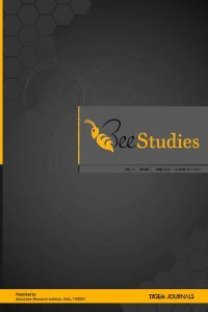Classification of the Provinces of the Black Sea Region in Terms of Beekeeping
This study aims to group the Black Sea provinces, which hold 27.48% of the honey production in Turkey, by cluster analysis. For this purpose, the number of beekeeping enterprises in the Black sea region, the total number of colonies (traditional and modern), honey production, and beeswax production data gathered from the Turkish Statistical Institute (TURKSTAT) between 2016 and 2020 were used. As a result of the analysis, the Black sea region provinces were clustered into three groups based on their colony count and production. The first group consisted of; Amasya – Gümüşhane, Bayburt – Tokat, Düzce, Bolu – Karabük provinces, and Zonguldak – Çorum, Sinop provinces. The second group consisted of; Artvin, Kastamonu – Samsun, Bartın, Giresun – Trabzon, Rize provinces. The only province in the third group was Ordu. Assessing their development levels in regards to beekeeping practices may provide an opportunity for grouping provinces that are similar in terms of their product type, especially for apitherapy, health, cosmetics, and edible products to help them specialize in certain products. Determining these groups might also make it possible to carry out training and extension programs in a more organized way. Thus, it is thought that the contribution to the country's economy will increase by providing sustainable and economic production.
Keywords:
Honey bee, Apis mellifera L. Beekeeping, Black Sea, Classification,
___
- Abacı, N. İ., Abacı, S. H., & Bıyık, S. (2020). Forecast for the Number of Colonies and Honey Yield in Turkey. Turkish Journal of Agriculture-Food Science and Technology, 8(2), 464-470.
- Anonymous, 2020. Arıcılık raporu. Ordu Ticaret Borsası, https://www.ordutb.org.tr/wp-content/uploads/2020/10/Aricilik-Raporu.pdf
- Akkaya, H. (2007). Beekeeping in Anatolia from the Hittites to the present day. Journal of Apicultural Research, 46(2), 120-124.
- Akyol, E., Şahinler, N., & Özkök, D. (2006). Honeybee (Apis mellifera) races, ecotypes and their general characteristics in Turkey. J. Anim. and Veter. Advances, 5(9), 771-774.
- Bodenheimer, F. S. (1942). Studies on the honeybee and beekeeping in Turkey. Merkez Zirai Mücadele Enstitüsü Ankara, Turkey.
- Burucu, V., & Gülse Bal, H. S. (2017). Türkiye’de arıcılığın mevcut durumu ve bal üretim öngörüsü. Tarım Ekonomisi Araştırmaları Dergisi, 3(1), 28-37.
- Çevrimli, M. B., & Sakarya, E. (2018). Türkiye arıcılık sektöründe mevcut durum, sorunlar ve çözüm önerileri. Erciyes Üniversitesi Veteriner Fakültesi Dergisi, 15(1), 58-67.
- Dodoloğlu, A., & Genç, F. (2002). Kafkas ve Anadolu Balarısı ırkları ile karşılıklı melezlerinin bazı fizyolojik özellikleri. Turk. J. Vet. Anim. Sci, 26, 715–722.
- FAO, (2021). Food and Agriculture Organization of the United Nations Classifications and Standards. http://faostat.fao.org
- Fıratlı, Ç., Genç, F., Karacaoğlu, M., & Gencer, H. V. (2000). Türkiye Arıcılığının Karşılaştırmalı Analizi Sorunlar-Öneriler. V. Türkiye Ziraat Mühendisliği Teknik Kongresi, 17-21.
- Genç, F., Dülger, C., Kutluca, S., & Dodoloğlu, A. (1997). Kafkas, Anadolu ve Erzurum balarısı (Apis Mellifera l.) genotiplerinin bazı morfolojik özelliklerinin belirlenmesi. Atatürk Üniversitesi Ziraat Fakültesi Dergisi, 28(5), 683-697.
- Güler, D. (2021). Türkiye’de İllere Göre Arıcılık Etkinliğinin Veri Zarflama Analizi ile Belirlenmesi. Uludağ Arıcılık Dergisi, 21(2), 146-156.
- Günbey, B., & Cengiz, F. Karadeniz Bölgesindeki Bazı Bal Arısı (Apis mellifera L.) Genotiplerinin Bölge Koşullarındaki Performansları. Ziraat Mühendisliği, 371, 113-123.
- Kandemir, I., Kence, M., & Kence, A. (2000). Genetic and morphometric variation in honeybee (Apis mellifera) populations of Turkey. Apidologie, 31, 343–356.
- Keleş, O. C., Demir, N., & Eyduran, E. (2019). Trabzon ilinde IPARD programı kapsamındaki arıcılık hibelerinin etkinliğinin belirlenmesi. SETSCI Conference Proceedings, 4(8), 203-207. doi: https://doi.org/10.36287/setsci.4.8.037.
- Kuvancı, A., Yılmaz, F., Öztürk, S. H., Konak, F., & Buldağ, M. (2017). Doğu Karadeniz Bölgesi Arıcılığına Genel Bakış. Arıcılık Araştırma Dergisi, 9(2), 47-55.
- Minitab, LLC. (2021). [Computer software]. State College, PA: Minitab, Inc.
- Okuyan, S., Mehmetoğlu, S., & Çakıcı, N. (2020). Antioxidant Variability of Propolis Collected from Different Zones in Hives. Bee Studies, 12(1), 1-4.
- Özdamar, K. (2004). Paket Programlar ile İstatistiksel Veri Analizi (Çok Değişkenli Analizler). Kaan Kitabevi.
- Özkırım, A. (2018). Beekeeping in Turkey: Bridging Asia and Europe. In Chantawannakul, P., Williams, G., & Neumann, P. (Eds.), Asian Beekeeping in the 21st Century (pp.41-69). Springer Nature Singapore Pte Ltd.
- Palmer, M. R., Smith, D. R., & Kaftanoglu, O. (2000). Turkish honeybees: genetic variation and evidence for a fourth lineage of Apis mellifera mtDNA. Heredity, 91, 42–46.
- Ruttner, F. (1988). Biogeography and Taxonomy of Honeybees. Springer.
- Sıralı, R., & Cınbırtoğlu, Ş. (2018). Ormangülü (Rhododendron) Türlerinin Bazı Özellikleri ve Arıcılık Açısından Önemi. Journal of Apiculture Research, 10(2), 45-53.
- Smith, D.R., Slaymaker, A., Palmer, M., & Kaftanoglu, O. (1997). Turkish honeybees belong to the east Mediterranean mitochondrial lineage. Apidologie, 28, 269–274.
- Sorkun, K. (2007). Türkiye’nin Nektarlı Bitkileri Polenleri ve Balları. Palme Yayınevi.
- TURKSTAT.(2021). Turkish.Statistical.Institute. http://www.tuik.gov.tr
- ISSN: 2757-5438
- Yayın Aralığı: Yılda 2 Sayı
- Başlangıç: 2009
- Yayıncı: Arıcılık Araştırma Enstitüsü Müdürlüğü
